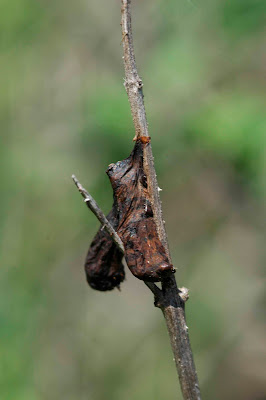 |
| More melting caterpillars, this one on a dead lantana stem. |
 |
| I spotted another dead one on a different stem. |
 |
| This small unidentified caterpillar was alive. |
 |
| I'm only posting this damselfly because while I was shooting it.... |
 |
| ...I happened to see ANOTHER dead caterpillar on a blade of grass! |
 |
| Found on our wooden arbor...another Grote's buck moth (Hemileuca grotei), according to Bugguide.net. "Once again based on the red coloration between segments," Ryan wrote. "Hemileuca peigleri is the only other Hemileuca sp. I would expect from Blanco County. Although the orange spines are reminiscent of H. peigleri in the guide, I have not seen the red intersegment coloration in peigleri (at least in the images I have seen)." |
 |
| A chrysalis also on the arbor, probably a Gulf fritillary since there are passionflower vines nearby. |
 |
| "GET YOUR CAMERA!" James hollered again today. "Got a caterpillar for you!" "Is it ALIVE?" I asked. Yes, James said. Resembles a lichen, eh? |
 |
| And boy, was it! Whenever we nudged it, it flipped and hurled itself like a jumping bean. It also released some fluid. |
 |
| Thanks to experts at Bugguide.net, I now know that this guy is an ilia underwing (Catocala ilia). |
4 comments:
Hi...Your blog was the first I came across this morning after discovering more 'melted' caterpillars around my home in the Copperas Cove area...Since the beginning of spring, I have noticed caterpillars wandering aimlessly, and others motionless on a stick...When the motionless ones are touched, they melt as you say...This morning on 4-1, I noticed about 20 caterpillars on one of my compost bins just wandering around like they were zombies, also I found many more motionless ones that liquidated at a touch, in addition to the many I have found throughout the past weeks...I decided to search finding your blog, and what it is...It's a virus infecting these caterpillars called the, Zombie Caterpillar Virus...This is the first time I have seen this in Texas and it seems to be hitting hard in this area...The article on Live Science is a good read and somewhat frightening in nature...I do not know if I can drop the link here but it is on 'treehugger . com' under the title 'Scientists Discover Gene Behind Melting Zombie Caterpillars'...The photos are very good like yours...Have a good afternoon, great photos...
It's VERY frightening. What about the birds that eat these sickened caterpillars? We humans have really messed up our world and ecosystems. Everything is so out of balance. Two or so summers ago (I reported my observations here on my blog), I found dying Gulf fritillary caterpillars on our passionflower vine.
If you run across more info, let me know!
A direct quote from LS.
'This species of baculovirus infects only gypsy moth caterpillars, essentially turning them into zombies. It stops the caterpillars from molting and sends them up into the tree leaves during the day (a behavior they normally save for the cover of darkness), where they die among the leaves as they wait to molt.'
The real issue is the 'goo' they turn into actually spreads the virus to others that walk through it...Birds as you mentioned help spread it by touching the leaves and further dispersing the goo in droplets...So it's one gene in the virus named 'egt' that causes this, of course man has learned to harness this and use it...
The article also states that.
'In fact, the forestry service uses these viruses to control outbreaks of gypsy moth caterpillars in areas where pesticides might harm endangered insects.'
I find the last part scary to say the least that A. we are harnessing a virus with specific genes that will kill off a species. and B. we are tampering with nature on a biological, molecular level, which rarely turns out good...
So the question now is...Did someone spray a substance to do this via airplane dispersal to control the population of the gypsy moth recently, and what is it going to do to us?
Or, has this virus just popped up and reared it's ugly head for a season due to the drought and now overly wet environment?
Thanks again...
Luke..
The thing is, we've spotted in a number of different places....on the brick exterior of our house, a concrete bench, grass blades, lantana stem and others. It's hard to tell the species because the larvar are often past recognition. I need to read about this further. Thanks!
Post a Comment